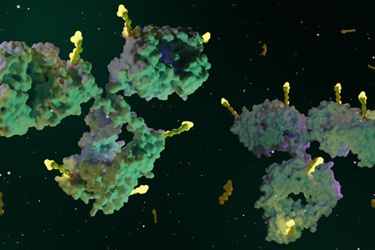2023 ADC Roundup: A Year Of Collaboration And Licensing Deals

By Tyler Menichiello, contributing editor

Despite the continuation of a poor funding climate in biotech, 2023 was a big year for antibody-drug conjugates (ADCs). In total, there were 76 ADC deals made (as of December 26, 2023) — ranging from licensing agreements to collaborations and acquisitions. In many ways, this validates the industry’s positive outlook for the ADC market my colleague and chief editor of Bioprocess Online, Matt Pillar, shared back in February.
To dive into the details and makeup of 2023’s ADC market frenzy, I met with my go-to ADC guru, Dr. Joe Daccache, and his fellow life science analyst at DeciBio, Rebecca Bair. Without Daccache’s meticulous (borderline obsessive) monitoring of the ADC market, and Bair’s expert data assembly, none of these insights would be in my hands — so a big thanks to them!
Editor’s Note: While this is a recap of ADC deals seen in 2023, stay tuned for more ADC content coming soon — including the results from DeciBio’s ADC 2024 Industry Outlook Survey, which you can participate in here.
The Deals By The Numbers
On average, the ADC space saw about 6 deals per month in 2023, with October being the busiest (11 deals) and June being the slowest (zero). Of the 76 deals DeciBio tracked in 2023, licensing agreements made up the majority of transactions (37), followed by collaborations and partnerships (23), acquisitions (10) and miscellaneous mergers, asset purchases, and development agreements (6).

Despite only making up 13% of transactions, acquisitions account for the majority of dollars spent in the space (around $54 billion), followed by collaborations (around $36 billion) and licensing deals (around $27 billion). The biggest deal (by a very wide margin) was Pfizer’s $43 billion acquisition of Seagen. To put that in context, the second largest deal was Merck’s collaboration with Daiichi Sankyo, valued at $16.5 billion.

The ADC field saw a lot of investments in 2023. The average fundraising amount was $84.4 million, with $760 million raised in total. Venture capital (VC) transactions were largely Series A funding, with Series B and C deals representing a smaller fraction. Daccache says this highlights the boom of new ADC companies being created.

The majority of deals in 2023 were focused on technology platforms (e.g., linker and conjugation technologies). Of the deals that disclosed targets and technologies, approximately 28% focused specifically on linkers. While many deals did not publicly disclose or specify therapeutic targets, for those that did, HER3, HER2, Claudin 18.2, Trop2, and Nectin-4 were among the most popular. “These targets and their intended indications are pretty diffuse,” Bair says. “Some are for ovarian or endometrial cancers; others are meant for more breast and lung cancers — it kind of covers the whole cancer space across different subtypes. This is pretty ubiquitous amongst deals this year, which I think is important.”

ADCs Are Taking Off, This Is Just The Beginning


